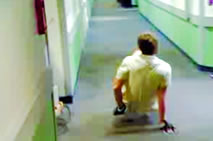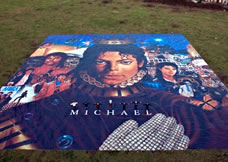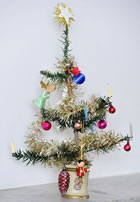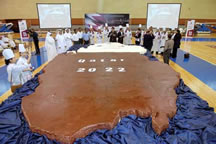
More than 10 million people living in Britain today, almost a fifth of the population, will reach their 100th birthday, the Department for Work and Pensions said on Thursday.

 . 'The Fame Monster', a repackaged version of her earlier disc 'The Fame', sold 5.8 million copies across the globe, according to the United World Chart, compiled by website mediatraffic.de.
. 'The Fame Monster', a repackaged version of her earlier disc 'The Fame', sold 5.8 million copies across the globe, according to the United World Chart, compiled by website mediatraffic.de.

 Capping the UN's International Year of Biodiversity, botanists in Britain and the United States on Wednesday unveiled a library of plant names aimed at helping conservationists, drug designers and agriculture researchers.
Capping the UN's International Year of Biodiversity, botanists in Britain and the United States on Wednesday unveiled a library of plant names aimed at helping conservationists, drug designers and agriculture researchers. Two Berlin police officers were pelted by snowballs thrown by a group of about 40 youths but were able to fight them off with pepper spray, police said on Sunday. |



| Investors have received nearly double profit by investing in gold and silver this year, Geo News reported on Monday. |

| Teams of scientists have cracked the genetic codes of the wild strawberry and a certain type of cacao used to make fine chocolate, work that should help breeders develop better varieties of more mainstream crops. |


 Moreover, inside the World's Biggest Dumpling there are 2,011 small dumplings. Those small dumplings have different flavors and can feed 100 people at the same time.
Moreover, inside the World's Biggest Dumpling there are 2,011 small dumplings. Those small dumplings have different flavors and can feed 100 people at the same time.


| Norwegian reindeer owners have a Christmas safety tip for Santa -- put reflectors on the fleet-footed animals so they won't get hit by cars. |

| The design for an official commemorative coin to mark the engagement of Britain's Prince William and Kate Middleton was unveiled on Thursday, but not everyone might recognize the bride-to-be. |


| Sony is planning to buy back a Japanese factory from Toshiba as it seeks to double output for sensors used in cameras and smartphones amid rising global demand, reports said Thursday. |

| The U.S. teen birthrate dropped to its lowest level in the seven decades government researchers have been tracking it, government researchers said on Tuesday. |
 Michael Jackson's posthumous album - setting the new world record for the Largest poster.
Michael Jackson's posthumous album - setting the new world record for the Largest poster.
 14-inch tree originally bought in 1886 which now belongs to Paul Parker, 45, of Bath, England, valued at $1,585, sets the world record for the Oldest Artificial Christmas Tree. The mini-tree is made of a green fibrous material and sits on a base decorated with cherubs, Jesus and Mary.
14-inch tree originally bought in 1886 which now belongs to Paul Parker, 45, of Bath, England, valued at $1,585, sets the world record for the Oldest Artificial Christmas Tree. The mini-tree is made of a green fibrous material and sits on a base decorated with cherubs, Jesus and Mary.
 was prepared by The Ritz-Carlton Doha for Qatar Foundation for Combating Human Trafficking's (QFCHT) national day programme.
was prepared by The Ritz-Carlton Doha for Qatar Foundation for Combating Human Trafficking's (QFCHT) national day programme.
| A total eclipse of the moon Monday night will coincide with winter solstice, which means the moon will appear high in the sky and be visible throughout all of North and Central America, including Seattle — weather permitting. Starting around 10:33 p.m. PST, the full moon, normally illuminated by the sun, will pass through the shadow, or umbra, created by Earth blocking the sun's light. Some indirect sunlight still will manage to pierce through and give the moon a ghostly color — brown or maybe deep red rather than the usual orange-yellow tinge, thanks to recent volcanic eruptions that have dumped tons of dust into the atmosphere. The sky will darken as the shadow progresses across the moon, and more stars will appear in the sky as sunlight reflected from the moon fades. The forecast for the Seattle area is for mostly cloudy skies, with showers. Unlike a total solar eclipse, when the sun is blotted out, a lunar eclipse rarely turns the moon totally black. Because of sunrises and sunsets that scatter and refract light from the sun around the world, the moon generally appears bright and coppery orange, or sometimes brown or dark red-black, depending on how much pollution is in the atmosphere. The most recent total eclipse of the moon was on the night of Feb. 20-21, 2008. Totality will last a generous 72 minutes, and the process then will reverse, with the moon completely emerging from the umbra at 2:01 a.m. Tuesday. "It's perfectly placed so that all of North America can see it," said eclipse expert Fred Espenak of NASA's Goddard Space Flight Center. Also unlike a solar eclipse, which generally can be seen only from selected places on Earth, a lunar eclipse can be seen from anywhere on the side of the planet facing the moon. The next lunar eclipse will be on June 15, but North America will miss out because the continent will be facing the wrong way. Another eclipse will occur Dec. 10 but will be interrupted by moonset and sunrise. The next total lunar eclipse for the entire continent won't occur until April 14-15, 2014, an unusually long wait. |

| A total eclipse of the moon Monday night will coincide with winter solstice, which means the moon will appear high in the sky and be visible throughout all of North and Central America, including Seattle — weather permitting. Starting around 10:33 p.m. PST, the full moon, normally illuminated by the sun, will pass through the shadow, or umbra, created by Earth blocking the sun's light. Some indirect sunlight still will manage to pierce through and give the moon a ghostly color — brown or maybe deep red rather than the usual orange-yellow tinge, thanks to recent volcanic eruptions that have dumped tons of dust into the atmosphere. The sky will darken as the shadow progresses across the moon, and more stars will appear in the sky as sunlight reflected from the moon fades. The forecast for the Seattle area is for mostly cloudy skies, with showers. Unlike a total solar eclipse, when the sun is blotted out, a lunar eclipse rarely turns the moon totally black. Because of sunrises and sunsets that scatter and refract light from the sun around the world, the moon generally appears bright and coppery orange, or sometimes brown or dark red-black, depending on how much pollution is in the atmosphere. The most recent total eclipse of the moon was on the night of Feb. 20-21, 2008. Totality will last a generous 72 minutes, and the process then will reverse, with the moon completely emerging from the umbra at 2:01 a.m. Tuesday. "It's perfectly placed so that all of North America can see it," said eclipse expert Fred Espenak of NASA's Goddard Space Flight Center. Also unlike a solar eclipse, which generally can be seen only from selected places on Earth, a lunar eclipse can be seen from anywhere on the side of the planet facing the moon. The next lunar eclipse will be on June 15, but North America will miss out because the continent will be facing the wrong way. Another eclipse will occur Dec. 10 but will be interrupted by moonset and sunrise. The next total lunar eclipse for the entire continent won't occur until April 14-15, 2014, an unusually long wait. |






 £1M Swarovski Crystal Violin in an astonishing 58.515 seconds - setting the new world record for the Fastest Violin Player.
£1M Swarovski Crystal Violin in an astonishing 58.515 seconds - setting the new world record for the Fastest Violin Player.



| WASHINGTON: Crimes committed on Facebook have soared 7,400% in the past three years. The website has been used by perverts to groom victims and by criminals to make threats, intimidate, bully and harass people. |








| CAPE CANAVERAL: Technical issues have forced Space Exploration Technologies to postpone Tuesday's planned launch of its Falcon 9 rocket and Dragon capsule, which NASA wants for cargo runs to the International Space Station after its space shuttles are retired next year. |

